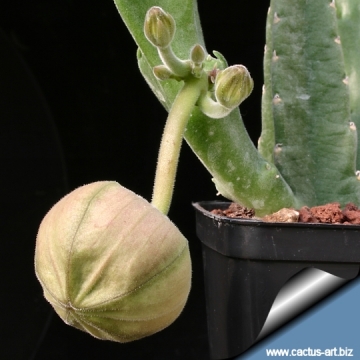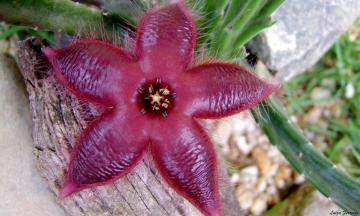= Stapelia asterias Masson
Stapel. Nov. 14, t. 14 14 1797. [Mar 1797] Masson
Accepted Scientific Name: Stapelia hirsuta L. L.
Sp. Pl. 1: 217 (1753) L.

Gonostemon asterias (Stapelia asterias) Photo by: Luiza Ferreira
Origin and Habitat: Native of the deserts of southern Africa
Synonyms:
See all synonyms of Stapelia hirsuta L.
back
Accepted name in llifle Database:Stapelia hirsuta L. L.Sp. Pl. 1: 217 (1753)Synonymy: 51
back
Common Names include:
ENGLISH: Star-Fish Stapelia, Carrion Flower, Star Fish Flower, Starry stapelia
GERMAN (Deutsch): Aasblume
RUSSIAN (Русский): Стапелия звездообразная
Description: Stapelia asteriasSN|17384]]SN|19201]] is a tufted cactus-like mat-forming plant with large and showy star-fish shaped flowers. Stapelia asteriasSN|19201]]SN|19201]] is a very variable species with many hybrids both in the wild and in cultivation. This specie meets and intergrade with Stapelia grandifloraSN|19201]]SN|17384]] in the little Karoo and the two (quite similar) species can be separated by its thinner pedicel.
Habit: It is a relatively large, perennial, stem succulent that can form large compact clusters up to 40 cm in diameter (or more).
Stems: Erect or ascending 10-25 cm tall 1,4-2 cm in diameter. Soft, minutely downy, pale green or reddish with upright hooked tubercles and remnants of rudimentary leaves down the ridges. Stems are clavate, attenuated, four cornered lengthwise, a factor which allows expansion and contraction to compensate without harm for any excess or shortness of fluids inside; hence they may appear flat- or sunken-sided according to the availability of water. This is the "succulence" and a storehouse for nutrients, which are crucial to their survival in harsh, xeric habitats.
Flower: Blooms 1-5 per head produced from the base on younger shoots, wide star fish-shaped, Pedicels 3-7 cm long, 4-5 mm in diameter, thickened at the base about the length of the corolla. Corolla width very variable, usually 7-11 cm across, very deeply lobed. Limb shallowly concave. Corolla segments ovate acuminate, wrinkled, revolule, reflexed and usually hairless except for long hair at the edge, inside purplish, orange, dark-red, deep brown-purple shiny, sometimes partly tramversely yellow-lined and densely covered by sparse and short purplish hairs, but longer and denser in bands radiating towards lobe-sinuses. Undersides red to greenish. Outer corona-lobes more or less oblong, approx 5 mm; inner corona-lobes 6-7 min high, inner horn erect or somewhat recurved, awl-shaped. partly or completely united with outer wing. Buds plump peaked that resemble the domes of a Russian Orthodox church. Flowers smell like rotting meat and are very attractive to the flies that pollinate them. Sometimes flies lay eggs on the flower. Larvae that have hatched from the eggs can be seen on the flower.
Fruit: Flies pollinate the flowers resulting in the typical twin seed horns (follicles), which are decorative in themselves and often don't appear until a year later.
Blooming season: Flowers are intermittently produced throughout the late summer and autumn.
Subspecies, varieties, forms and cultivars of plants belonging to the Stapelia hirsuta group
Bibliography: Major references and further lectures
1) George Don “A General System of Gardening and Botany” Rivington, 1838
2) White & Sloane. “The Stapelieae” edn 2. Abbey San Encino Press, 1937
3) “Encyclopaedia Londinensis, or, Universal dictionary of arts, sciences, and literature" Volume 23 1828
4) James Cullen, Sabina G. Knees, H. Suzanne Cubey “The European Garden Flora Flowering Plants: A Manual for the Identification of Plants Cultivated in Europe, Both Out-of-Doors and Under Glass” Cambridge University Press, 11/Aug/2011
5) Carl August Lückhoff “The stapelieae of Southern Africa” A. A. Balkema, 1952
6) Doreen Court “Succulent Flora of Southern Africa” A.A. Balkema, 2000
7) Hermann Jacobsen “A handbook of succulent plants: descriptions, synonyms, and cultural details for succulents other than Cactaceae", Volume 1 Blandford Press, 1960
8) Alison Heath, Roger Heath “Field guide to the plants of northern Botswana, including the Okavango Delta: useful in countries and geographical areas adjacent to northern Botswana in the Zambesi Basin” Royal Botanic Gardens, Kew, 15/Jun/2010
9) Bruyns, P.V. "Stapeliads of Southern Africa and Madagascar" Volume I Umdaus Press, Hatfield, South Africa Pages 257 - 259 2005
10) Golding, J.S. "Southern African Plant Red Data Lists." Southern African Botanical Diversity Network Report No. 14. SABONET. Pretoria. Page 162. (ed.) 2002
11) Mapaura, A & Timberlake, J. "A checklist of Zimbabwean vascular plants" Southern African Botanical Diversity Network Report No. 33 Sabonet, Pretoria and Harare Page 21. (eds) 2004
12) Focke Albers und Ulli Meve (Hrsg.): “Sukkulenten-Lexikon" Volume 3 Asclepiadaceae” Ulmer, Stuttgart 2002
13) George Don “A General System of Gardening and Botany” Rivington, 1838
14) Leach, L. C. "A revision of Stapelia" L. Excelsa Taxon. Ser. 3: 1–157 198514)
15) John Sims “Curtis's Botanical Magazine” - Volums 15-16 - Page 536 1801
16) Yvonne Cave “Succulents for the contemporary garden” 2003
17) Sajeva, Maurizio and Costanzo, Mariangela. "Succulents: The Illustrated Dictionary" Portland, Ore.: Timber Press, 1994.
 Gonostemon asterias (Stapelia asterias) Photo by: Cactus Art
Gonostemon asterias (Stapelia asterias) Photo by: Cactus Art Gonostemon asterias (Stapelia asterias) Photo by: Luiza Ferreira
Gonostemon asterias (Stapelia asterias) Photo by: Luiza Ferreira Gonostemon asterias (Stapelia asterias) Photo by: Luiza Ferreira
Gonostemon asterias (Stapelia asterias) Photo by: Luiza FerreiraSend a photo of this plant.The gallery now contains thousands of pictures, however it is possible to do even more. We are, of course, seeking photos of species not yet shown in the gallery but not only that, we are also looking for better pictures than those already present.
Read More... Cultivation and Propagation: Stapelia asterias is an easy obliging blooming plant when mature, which is happy in any average succulent house.
Soil: Since roots are quite shallow, use a cactus mix or add extra perlite or pumice to regular soil potting soil. A gritty, very free-draining compost is suitable, and clay pots help the plants to dry out between watering.
Watering: Stapelia require moderately watering through the growing season but enjoy plenty of water and some fertiliser in hot weather, this helps them to flower freely. Water more sparingly in winter according to temperatures. But, as with most asclepiads, it is unwise to leave them wet in cold weather.
Hardiness: Winter care presents no problems at 5°C with plenty of light.
Sun Exposure: Partial sun or light shade.
Pest and diseases: Stapelia species vary in their susceptibility to rotting, but are generally fairly easy to grow, especially if kept pest-free. They are very susceptible to stem and root mealy bugs, and damage from these may well initiate fungal attack. If you do have problems with a stem or with basal rotting, you can reliably isolate the healthy parts, dry them off, and re-root them in moist compost.
Cultural Practices: Re-pot every 2 years.
Propagation: Easiest with stem cuttings. Allow cuttings to dry a day before planting. Stems must be laid (Not buried) on gritty compost and will then root from the underside of the stems. It can also be increased from seeds sowing in spring in moist, sandy peat moss. Barely cover seeds.














